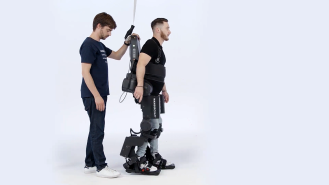The FDA has cleared the self-balancing Atalante exoskeleton for use during stroke rehab — helping stroke survivors stay upright while relearning how to walk.
Stroke rehab: A stroke occurs when the vessels supplying blood to the brain are blocked or burst. Without blood supply, brain cells begin dying within minutes — that can lead to brain damage that affects a person’s ability to talk, walk, and control their limbs.
Stroke rehab can help survivors recover some or even all of the abilities lost after the event. Usually, rehab starts in a healthcare setting, and it may include gait-training exercises, such as walking with crutches or between parallel bars.
These exercises can help ensure a person is able to safely walk after their stroke — a major factor in quality of life and independence — but if the stroke left them with significant upper body mobility issues, too, they might have trouble using crutches or supportive bars.
“Our model is the only one that balances itself.”
Jean-Louis Constanza
Robots to the rescue: The FDA has now cleared Atalante, an exoskeleton developed by French robotics company Wandercraft, for stroke rehab in a medical setting.
The Atalante exoskeleton is hand-free and self-balancing, giving stroke survivors the ability to practice gait training even if mobility issues in their upper body prevent them from being able to use a walker or bars.
“Our model is the only one that balances itself and does not require the use of crutches for stabilization,” Wandercraft co-founder Jean-Louis Constanza told France 24 in November 2022.
The FDA’s decision was based in part on two clinical studies of 43 stroke survivors, which found that the Atalante exoskeleton can improve a patient’s balance and ability to walk if used early in their stroke rehab.
How it works: Once the Atalante exoskeleton is fastened to a user’s shoulders, chest, waist, knees, and feet, they can use a remote control to get it to help them stand. They can then walk in any direction, including backwards or side to side.
Atalante’s battery provides enough power for 2 hours of continuous use, and the level of assistance the exoskeleton delivers can be adjusted using connected software, which can also record the number of steps taken, a patient’s treatment progression, and more.
In a clinic, the exoskeleton hangs from a safety cable as an added precaution — the Atalante might be self-balancing, but if something unexpected happens, Wandercraft doesn’t want to risk having a patient fall down while wearing the device, which weighs 165 pounds.
“Just standing face-to-face with someone is so great.”
Virginie Dubost
The impact: While the FDA has only just cleared the Atalante exoskeleton in the US, Wandercraft has already deployed about 20 of the devices to hospitals in Europe at a cost of about $176,000 each.
Some of the patients at those facilities are using the exoskeleton for gait training, but others are paraplegics with no walking ability — for them, the exoskeleton provides a way to get upright and more around.
“Just standing face-to-face with someone is so great,” Virginie Dubost, who uses a wheelchair due to a surfing accident, told France 24. “I was a little exhausted the first time I tried it, but over time, I felt it strengthen my muscles and cardio.”
Constanza’s son Oscar is also an Atalante user — he has a neurological condition that affects his walking ability, and it was at his request that the senior Constanza began developing the exoskeleton.
“One day Oscar said to me, ‘Dad, you’re a robotic engineer. Why don’t you make a robot that would allow us to walk?’” Constanza told Reuters.
“Before, I needed someone to help me walk … this makes me feel independent,” said Oscar.
Looking ahead: In addition to getting its Atalante exoskeleton more widely deployed, Wandercraft is focused on developing a personal exoskeleton that people would be able to use outside the clinic.
“The finalized prototype of this new personal version will enable the user to sit, stand, walk, cook, bend down to grasp low objects and get into a car,” Constanza told E-Magazine. “They will be able to do pretty much everything any of us needs to be able to do, other than get into a bathtub full of water.”
We’d love to hear from you! If you have a comment about this article or if you have a tip for a future Freethink story, please email us at tips@freethink.com.
